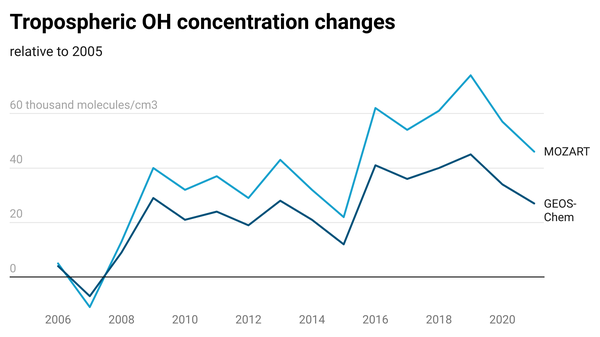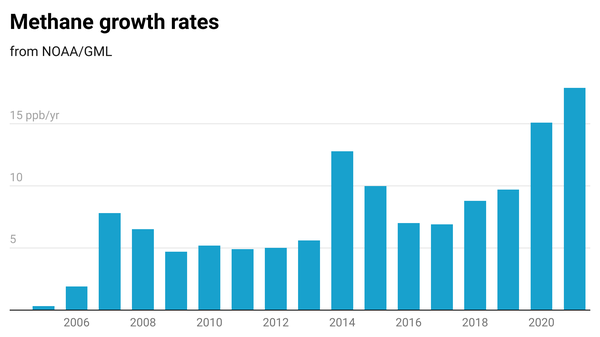Between 2005 and 2021, changes in air pollutants such as carbon monoxide, nitrogen oxides and ozone increased the capacity of the global methane sink by 1.3 to 2.0 teragrams per year, thereby slowing the growth of methane concentrations in the atmosphere. This is shown by a new study using satellite data continued by the RECCAP-2 project of ESA's Climate Change Initiative (CCI) and led by Yuanhong Zhao, Ocean University of China and Bo Zheng, Tsinghua University. The study has succeeded in establishing a measurable link between air quality and atmospheric methane degradation through hydroxyl radicals, the main ‘air purifier’ which cleans methane in the atmosphere. The RECCAP-2 project is developing monitoring systems that make complex atmospheric processes observable, providing policymakers with the data they need for integrated air and climate protection policies.
Research quantifies for the first time paradoxical effects of pollution control on methane degradation
In this recently published study, a remarkable paradox is quantified for the first time. While global efforts to reduce carbon monoxide emissions, for instance through more efficient combustion technologies in industry and transport, led to increased atmospheric methane degradation during the research period, rising concentrations of air pollutants such as nitrogen oxides and ozone also resulted in enhanced methane sink performance. These findings demonstrate the intricate chemistry of the atmosphere: enhanced air quality does not invariably result in increased methane degradation; rather, both 'clean' and 'polluted' air conditions can contribute to methane reduction. However, these changes vary spatially. In North America, Europe and China, reduced carbon monoxide emissions were the main factor behind increased methane sink performance. In contrast, in South Asia, rising nitrogen oxide emissions have driven this trend. Overall, the effect is most pronounced in tropical regions, where tropospheric ozone and water vapour have increased particularly strongly.

“For the first time, we can quantify the extent to which invisible chemical reactions in the atmosphere are combating climate change,” says Philippe Ciais, researcher at the Laboratoire des Sciences du Climat et de l'Environnement at Université Paris-Saclay. “The atmosphere has secretly helped us by increasing its capacity to absorb methane. However, these interactions between air pollutants and methane degradation are fragile, revealing conflicting goals between air pollution control and climate protection. This has important implications for future environmental policy.”
Satellite data makes invisible air purifiers measurable
After carbon dioxide, methane is the second most important anthropogenic greenhouse gas contributing to climate change. The atmosphere's ability to remove this gas depends on hydroxyl radicals (OH), often referred to as 'air purifiers'. OH is responsible for breaking down around 90 per cent of the methane released into the atmosphere by human activities, making it the most important chemical sink for methane. Changes in ozone, carbon monoxide, water vapour and nitrogen oxides influence the concentration of hydroxyl radicals in the troposphere, thereby indirectly affecting the capacity of the methane sink.

Tracking the presence of OH in the atmosphere is extremely difficult. The molecule is so rare that the total amount of OH in the atmosphere would weigh no more than a sheet of paper, making direct measurement impossible. However, using satellite observations of the pollutants with which OH reacts, the research team was able to calculate OH values retrospectively and reconstruct global trends in hydroxyl radicals and methane sinks through chemical models.
Extreme events have a significant impact on the methane budget
In addition to examining the interaction between air pollutants and methane degradation, the study documents the impact of extreme events such as El Niño, large-scale forest fires, and the COIVD-19 pandemic on the methane budget. During the pandemic, reduced nitrogen oxide emissions were found to lead to a decline in ozone, resulting in a short-term reduction in OH concentrations. This, in turn, reduced methane degradation and accelerated the increase in methane concentrations.
Large-scale forest fires increase carbon monoxide emissions, which reduces OH concentrations and weakens the methane sink. For example, during the extreme El Niño year of 2015, forest fires reduced the global methane sink capacity by around 17 million tonnes.
Environmental policy in a field of tension
The results reveal a fundamental conflict of objectives: while measures to reduce ozone and nitrogen oxides improve air quality and reduce health risks, they also unintentionally weaken the methane sink. Another challenge is that rising carbon monoxide emissions from an increasing number of forest fires could quickly offset the progress made in reducing anthropogenic emissions. These results highlight the need for effective climate and air policies that address both the sources and sinks of methane, as well as the importance of continuous monitoring of OH concentrations for effective management.
“Air pollutants influence the greenhouse gas methane both directly and indirectly, through their effect on the hydroxyl radical,” summarises Philippe Ciais. “To limit climate change in line with the UNFCCC's Paris Agreement, it is crucial to better understand the chemical interactions in order to effectively control the methane budget.”
Reference: Zhao, Y., Zheng, B., Saunois, M. et al. Air pollution modulates trends and variability of the global methane budget. Nature 642, 369–375 (2025). https://doi.org/10.1038/s41586-025-09004-z

